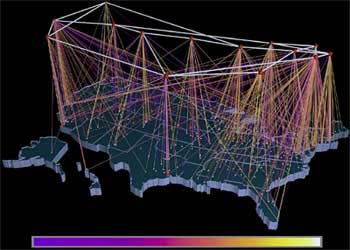

These materials also tend to have lower melting points.

Amorphous polymers are often transparent and, therefore, are used as food wrap, headlights, and contact lenses. If the arrangement has no particular order or form, like the arrangement of spaghetti on a plate, the polymer is said to be amorphous (having no shape). The polymer molecules can also have different arrangements. Polyethylene is the simplest example of a linear polymer. For example, the monomers may have a linear arrangement like a long chain of paper clips, although the tetrahedral carbon bonds actually give the chain a zigzag configuration. The monomers in a polymer may be arranged in a variety of ways. Although all plastics are in a liquid state at some point in processing and are solid in the finished state, once a thermoset polymer is formed, it cannot be melted and reformed. These polymers can be thermoplastic or thermosetting. Nylons, some polyesters, and urethanes are examples of condensation polymers. See the attached tables, Some Addition Polymers and Some Condensation Polymers, for examples of each type.ĭuring condensation polymerization a small molecule is eliminated as the monomers join together. They are easily processed, reprocessed, or recycled. These polymers are often thermoplastic in nature: they can be heated and made soft and then hardened when cooled. Polyethylene, polystyrene, and acrylic are examples of plastics formed by addition polymerization.

In this type of polymerization the monomers join by adding on to the end of the last “mer” in the chain, just like making a chain of paper clips. Addition polymerization has three basic steps: initiation, propagation, and termination. Monomers can be chemically joined together in two ways: addition polymerization or condensation polymerization. The industry produces approximately 150 kilograms of polymers per person annually in the United States. Today synthetic polymers in the form of plastics are in wide use, and the plastics industry is one of the fastest growing in the United States and around the world. Synthetic rubber was needed for tires, and nylon was needed as a replacement for silk for parachutes. However, it was not until the global disruption caused by World War II, when natural sources of latex, wool, silk, and other materials became difficult to obtain, that synthetics were mass produced. The first semisynthetic fiber, rayon, was developed from cellulose in 1911. The first totally synthetic polymer, Bakelite, was produced in 1907. Natural polymers, such as cellulose and latex, were first chemically modified in the 19th century to form celluloid and vulcanized rubber.

Although many polymers are hydrocarbons that contain only carbon and hydrogen, other polymers may also contain oxygen, chlorine, fluorine, nitrogen, silicon, phosphorus, and sulfur. Synthetic polymers include polyethylene (used in plastic bags) polystyrene (used to make Styrofoam cups) polypropylene (used for fibers and bottles) polyvinyl chloride (used for food wrap, bottles, and drain pipe) and polytetrafluoroethylene, or Teflon (used for nonstick surfaces). Naturally occurring polymers include tar, shellac, tortoiseshell, animal horn, cellulose, amber, and latex from tree sap. Polymerization can be demonstrated by making a chain using paper clips or by linking many strips of paper together to form a paper garland. The chain is made by joining, or polymerizing, at least 1,000 links together. A polymer can be thought of as a chain in which each link is the “ mer,” or monomer (single unit). The word polymer comes from two Greek words: poly, meaning many, and meros, meaning parts or units. A polymer is a substance made of many repeating units. Plastics are a group of materials, either synthetic or naturally occurring, that may be shaped when soft and then hardened to retain the given shape.


 0 kommentar(er)
0 kommentar(er)
